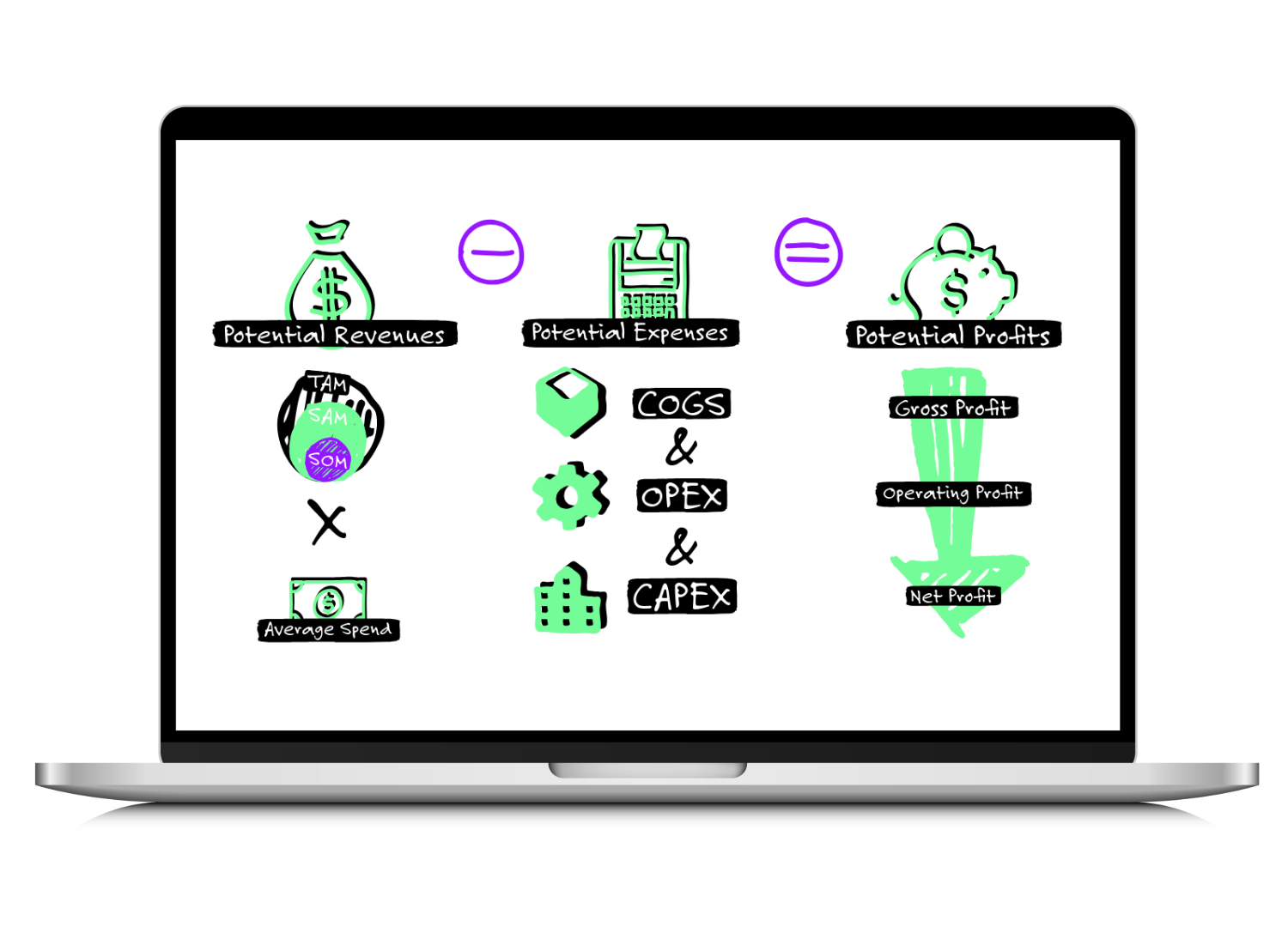Step 7: Make your Expense Projections
What expenses your business will incur and how to calculate them of course heavily depends on the nature of your business, a D2C brand that sells physical goods will have very different expenses from businesses that sell SaaS. So it would be impossible to provide a generalized approach on how to project your expenses. However, we will give you some guidelines to consider for the most common expenses.
Your COGS could include:
- Product Cost: Those are the expenses a business incurs when producing a good. They can include things like the raw material, supplies, packaging, labeling or if you hire a contract manufacturer to produce the goods for you, simply the cost of the finished product.
🧮To calculate these expenses a good starting point is the cost per unit, meaning how much it costs you to produce one unit of your product. You can then extrapolate this number by multiplying the unit cost with your expected sales volume (units). You also want to consider possible economies of scale, meaning that the unit cost will decrease the more units you produce.
→ cost per unit x sales volume in units
- Shipping & Fulfillment Cost: Those include for example the cost that incur for delivering your products to your customers. Of course those can also vary strongly depending on if you are delivering them directly to the home of your customers or if you are selling them through a wholesaler.
🧮However, to calculate them you could try to figure out how much “one” shipment costs and then multiply this cost by the number of shipments you will make. To estimate the number of shipments you will make divide the total sales volume (units) through the number of products your client purchases on average per order.
→ cost per shipment x number of orders (total sales volume/ average number of products per order)
- Direct Labor Cost: The direct labor cost are the salaries or wages you pay to those employees who are directly involved in producing a product or delivering a service. When running a service business like a consulting business or an agency those costs will account for the major part of your COGS.
🧮To calculate these expenses multiply the average salary per year by the number of Full Time Equivalents (FTEs) or in other words full time employees that you are going to require. Take into account that the number of FTEs likely increases the more your business grows over the years. On the other hand, the average salary probably also increases a little due to inflation.
→ average salary x FTEs
Your OPEX could include:
- Marketing, Advertising and Sales Cost: An important expense that any business will incur are the cost of marketing, advertising and sales. Especially when a brand is new and still unknown you will have to invest in these positions to generate brand awareness and acquire your first customers.
🧮One way to estimate your marketing and sales expenses is to apply a percentage of your planned revenue. This percentage of course heavily depends again on the nature of your business. B2C businesses usually invest heavier in marketing than B2B businesses for example. However, in general, it is common for businesses to allocate between 5-15% of their total revenue to marketing and sales expenses.
→ total potential revenues x x%
- Salaries & Wages: Those are the salaries and wages that you pay those employees who work in indirect positions, meaning jobs that are not directly related with the production of your goods or services like marketing, sales, finance etc.
🧮To estimate these expenses, define the job profiles you will need and research the average salaries for each profile.Then multiply the average salary per year by the number of Full Time Equivalents (FTEs) that you are going to require for each profile. Take into account that the number of FTEs likely increases the more your business grows over the years. On the other hand, the average salary probably also increases a little due to inflation.
→ average salary x FTEs
- Rent & Utilities: This is what you pay for the use of a building or property like for example an office or warehouse space, while utilities include the cost of electricity, gas, water, and other essential services needed to run the business.
🧮To estimate your expenses you can start by researching the average rental and utility costs in the area where you plan to operate your business. Look at the historical trends and projections for the next 5 years. Estimate the amount of space you will need, and calculate the corresponding rental costs for that space. Based on the size and type of your business, estimate the amount of utilities you will need, and calculate the associated expenses for each type of utility. Take into account the inflation rate and any potential market trends that may impact rental and utility costs over the next 5 years.
- Software Fees: Within your daily operations you will probably also use different software services for which you will have to pay monthly or annual fees.
🧮To estimate your spend on software fees, make a list with all the SaaS you are probably going to need. Go to their websites, check their prices, and calculate how much you will have to spend every year in fees.
- Website Hosting & Maintenance: Any business nowadays will usually have a website or an online shop even if it is a very simple one, so usually any business will incur some type of cost for website hosting and maintenance.
🧮To get an idea about your website expenses, go and check the plans offered by the different hosting providers, you probably already chose on to build your MVP. Use those prices to calculate your annual spend. Also take into consideration that usually the prices for website hosting are tied to the website traffic, so with increasing website traffic you will probably also have increasing website cost for a higher plan.
- Professional Fees: Those are expenses that a business incurs for the services of professionals such as lawyers, accountants, consultants, and other experts. These fees may be one-time or ongoing, depending on the nature of the services provided.
🧮To estimate these expenses you can start by researching industry standards for professional fees in your particular sector. Some factors that may influence professional fees include the size and complexity of your business, the level of expertise required, and the nature of the services provided. It’s important to consider potential changes in your business over time.. Some fees may be incurred early on in your business’s life, while others may be ongoing or increase as your business grows.
Your CAPEX could include different types of assets such as equipment, machinery and so on. The price you paid for those assets is not directly considered an expense in your P&L. What is considered an expense is the annual depreciation or amortization (D&A) meaning the decrease in value of the asset over time.
While depreciation is used for tangible assets such as machinery, buildings, and vehicles. It represents the decrease in value of the asset over time due to wear and tear, obsolescence, or other factors.
Amortization, on the other hand, is used for intangible assets such as patents, copyrights, and trademarks. It represents the process of spreading out the cost of the intangible asset over its useful life.
There are several methods for calculating the depreciation of an asset, but one of the most common methods is the straight-line depreciation method. So to estimate the D&A of your assets you can:
- Determine the cost of the asset, including the purchase price, delivery and installation costs, and any other costs associated with getting the asset ready for use.
- Determine the estimated useful life of the asset, meaning the length of time the asset is expected to be in use. The useful life can be estimated based on factors such as the asset’s expected wear and tear, technological advances, and changes in demand for the asset.
- Subtract the estimated salvage value from the cost of the asset, the salvage value is the estimated value of the asset at the end of its useful life. This is the amount that the company expects to receive if it sells the asset at the end of its useful life.
- Divide the resulting value by the estimated useful life (in years), this gives you the amount of depreciation that should be deducted each year.
Now go ahead and try to estimate the value of the different cost you listen in the tab “Potential Expenses” in your Business Case 📒Template.




